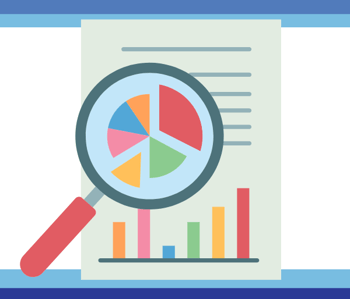MAT Reporting for UDS
Data must be collected and reported in various metrics when providing MAT services. Focusing on UDS submission, MAT services are reported on Staff and Utilization and Table 5: Selected Service Details Addendum highlighting health center personnel, visits, and unique patients. They are also reported in Table 6A Line 19 capturing visits and unique patients with a diagnosis applicable to other substance-related disorders (other meaning not pertaining to alcohol or tobacco use disorder).
Appendix E:
Other Data Elements is the final location. This is where the number of providers (specifically physicians, certified nurse practitioners, physician assistants, and certified nurse midwives) report who provide services onsite or through a contract, that has a Drug Addiction Treatment Act of 2000 (DATA) waiver to treat opioid use disorder with medications specifically approved by the U.S. Food and Drug Administration (FDA) (i.e., buprenorphine). Understanding the reporting requirements for these metrics and confirming the appropriate setup within NextGen will help ensure that information is captured effectively and accurately.
As with all services rendered, encounters will contribute to financial reporting such as required for UDS Tables 8A and 9D. Configuration and appropriate mapping for these tables are not outlined in detail within this article.
Table 5: Staff and Utilization
When reporting staff and using services, it is recommended to understand the service categories required for reporting and then set up staff in the NextGen environment to match these service categories for proper reporting. The best place to document within NextGen the corresponding service category for staff is through the configuration of Providers in NextGen File Maintenance. Using the System tab of the File Maintenance Provider configuration allows you to identify the proper Taxonomy Code for the specified provider type. Choosing Provider Types in the File Maintenance Practice tab that mirrors the UDS required categories will ensure proper reporting. If the provider also has the Drug Addiction Treatment Act of 2000 (DATA) waiver, which allows them to prescribe certain medications containing buprenorphine to treat opioid addiction and dependence, their Narcotics Addiction Drug Enforcement Administration Number (NADEA Number) should also be recorded in File Maintenance under the Practice tab for that provider.
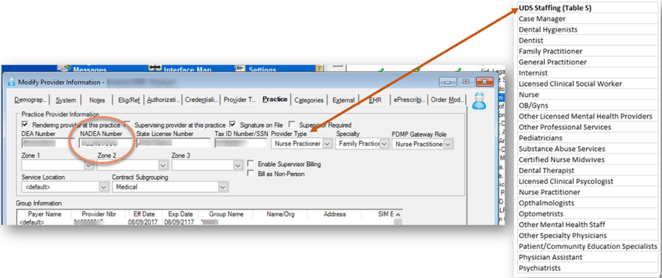
For proper MAT reporting, this is essential since physicians, NPs, PAs, CNMs, or Certified Registered Nurse Anesthetists (CRNAs) who have the DATA waiver to provide MAT services must be reported on Lines 1 -10 for Table 5 if they are medical providers, even if MAT is the only service they provide. Psychiatrists should be indicated as such for the Provider Type so they can be accurately captured and reported on Line 20a, and psychiatric NPs should be marked as Other Licensed Mental Health Providers and reported on Line20b. Under Substance Use Disorder Services (Line 21), all other personnel who provide this service will be indicated such as substance use disorder social workers, psychiatric nurses, psychiatric social workers, mental health nurses, clinical psychologists, and as any additional individuals providing substance use disorder treatment services.
Selecting the appropriate Specialty field in File Maintenance will help ensure providers are reported within the appropriate Lines for reporting. As mentioned, a Nurse Practitioner (not psychiatric NP) will be indicated in the Provider Type field in accordance with the UDS Staffing list provided. It is to be reported on Lines 1 -10 for Table 5 under medical, but if they provide MAT services in their Specialty Field “Addiction Medicine” could be selected thus indicating that they will also need to be reported in the Selected Service Detail Addendum for UDS.
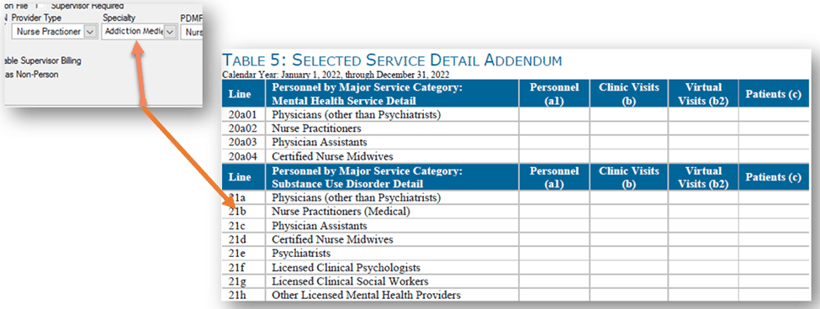
Table 5: Selected Service Detail Addendum
Beyond the main Table 5 reporting, mental health and substance use disorder services are also recorded in Table 5: Selected Service Detail Addendum. As briefly described in the example above, the addendum provides the opportunity to separate out the mental health and substance use disorder services issued by providers during a medical visit. Substance use disorder services provided by psychiatric providers would also be documented in this section if the visit was considered a visit to mental health in the main part of Table 5. Having the appropriate Provider Type and Specialty fields documented in File Maintenance will indicate which line a provider will need to be recorded for Table 5. Using resources such as event types for appointments will also help separate out the appropriate visits and patients.
In this example, Dr. Watson will be counted in Table 5 Line 1 since he is marked as a Family Physician in File Maintenance and this visit is counted as a medical visit. Since Dr. Watson also sees patients for MAT services as indicated by this event type, Dr. Watson and this visit will also need to be reported on Table 5: Selected Service Detail Addendum Line 21a for Substance User Disorder services.

Table 6A: Selected Diagnosis and Services Rendered
Capturing services not by the provider, but by the selected diagnosis is also considered a MAT service reporting requirement, as seen in Table 6A Line 19 for UDS reporting. This table is looking for visits and unique patients with a specific diagnosis, and other substance-related disorders (other meaning not related to alcohol or tobacco use disorder) are requested for Line 19. The applicable ICD-10-CM codes are outlined within each line and can be captured through simple mapping to a data reporting tool such as the UDSx Reporting Console. For MAT purposes, F11.20 for opioid dependence is often the diagnosis used and listed among the applicable coding criteria to be reported in Table 6A Line 19 for UDS reporting. Comparing the ICD-10-CM codes reported in this area with the codes in the type of SUD Services event, as shown above, can be used to confirm the accuracy of reporting between these two areas.

As stated in the 2022 UDS Manual Table 5 and Addendum Cross-Table Consideration, Table 6A for substance use disorder and mental health treatment are compared to the Table 5 addendum and the main part of Table 5 mental health and substance use lines, so ensuring the data documented in these locations aligns should be viewed as part of a routine validation process.
Appendix E: Other Data Elements Reporting Considerations
The final location MAT service is reported for UDS submission is in Appendix E: Other Data Elements. This appendix is where HRSA (Health Resources and Services Administration), wants to see collected information that is deemed crucial to highlight in the changing landscape of the Health Center program as they expand services and the delivery of services.
For the 2022 submission, the first question related to MAT services for opioid use disorder is how many providers located on-site or have a contract with the health center, have a DATA waiver to treat opioid use disorder with the specifically approved medications. Please note it does not require the provider to have provided MAT services, but the question just asks how many providers (physicians, certified nurse practitioners, physician assistants, and certified nurse midwives) have the DATA waiver during the calendar year. This is when the NADEA number for each provider documented within File Maintenance under the Practice tab is essential.
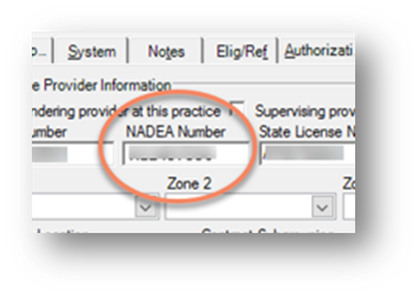 The second required reporting question in Appendix E related to MAT services is how many patients received MAT for opioid use disorder from a provider with a DATA waiver working on behalf of the health center during the calendar year. This total count could be captured by looking at unique patients captured in Table 5: Selected Service Detail Addendum Line 21a for Substance User Disorder services or Table 6A Line 19 looking at unique patients with the applicable ICD-10-CM code. This list will need to be compared with the list of providers included in the count for the previous question since not all providers who provided substance use disorder services necessary were MAT services or had the DATA waiver. Comparing this list with a specific event type for MAT appointments can help in ensuring reporting accuracy as well.
The second required reporting question in Appendix E related to MAT services is how many patients received MAT for opioid use disorder from a provider with a DATA waiver working on behalf of the health center during the calendar year. This total count could be captured by looking at unique patients captured in Table 5: Selected Service Detail Addendum Line 21a for Substance User Disorder services or Table 6A Line 19 looking at unique patients with the applicable ICD-10-CM code. This list will need to be compared with the list of providers included in the count for the previous question since not all providers who provided substance use disorder services necessary were MAT services or had the DATA waiver. Comparing this list with a specific event type for MAT appointments can help in ensuring reporting accuracy as well.
Strategies for Success
- Understand the requirements for MAT reporting for a specific quality program.
- Configure providers within the Systems and Practice field of NextGen File Maintenance to ensure personnel documentation will match the required reporting details for what needs to be captured.
- Establish specific event types so that encounter details can assist in capturing SUD services provided and aid in the validation process.
- Review data, at least on a quarterly basis. Staffing turnover, position changes, and various updates within the system can cause the information document within NextGen to misalign with proper reporting. Routine validation is essential for data reliability and ensures ease of capture when reporting is due.
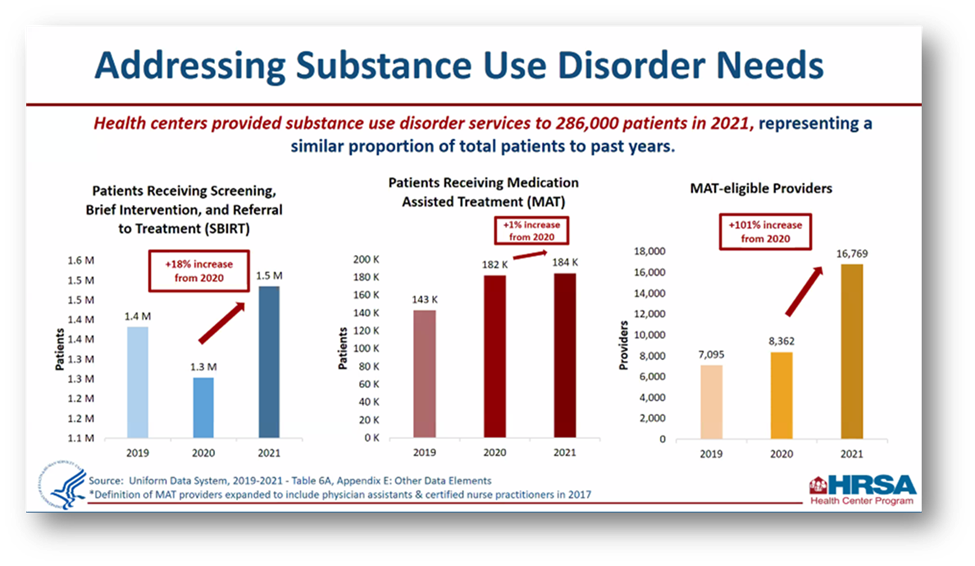
As shared in the HRSA 2021 UDS Trending webinar, MAT staff and the services they provide are dramatically increasing. Providing treatment for patients with substance use disorder needs is in demand, but to show the impact Federally Qualified Health Centers and Health Center Look-Alikes are making, proper reporting is key.
Resources:
HRSA 2021 UDS Trending webinar
